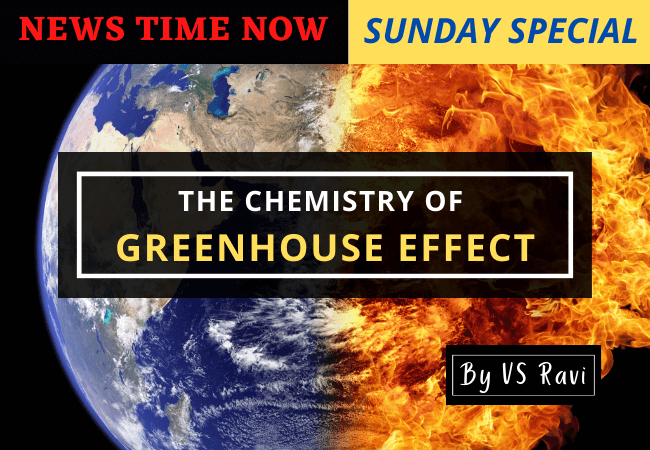Our earth would be a very cold place, with an average temperature of about 0 degree F instead of the more livable 63 degree that it is now if it weren’t for the Greenhouse Effect. But scientists are worried that our planet may be suffering from too much of a good thing. In recent years, human activity has contributed record amounts of gases to the atmosphere, creating a chemical shell that holds in the heat an threatens to change the world’s climate.
Just as sunlight passes through the glass roof of a greenhouse, solar radiation, in the form of short wavelengths, passes through the atmosphere that surrounds the planet. Fortunately, ozone in the stratosphere turns away most of the dangerous ultraviolet radiation that can wreak havoc on plants, animals, and humans. However, like the contents of a greenhouse, the warmed earth radiates heat in the form longer infrared wavelengths. Water vapour an certain other substances in the atmosphere absorb these longer wavelengths, trapping heat, rather like the way in which the glass in a greenhouse keeps the wind from stealing the heat trapped inside. Carbon dioxide, nitrous oxide, methane, and ozone are the substances called greenhouse gases.
Natural processes on earth have produced greenhouse gases for millions of years, as part of a complex system that maintains life. For example, carbon dioxide acts as a transport vehicle in the carbon cycle, trucking this essential element from biological warehouse to factory to warehouse in and endless loop. Carbon dioxide is a byproduct respiration in animals and bacteria, and is used by plants to make sugars for energy. It is constantly cycled through life forms, with some of it drifting into the atmosphere and some going into various kinds of storage facilities
All the living things on earth together store about 600 billion tons of carbon. As this living matter dies and decays or is burned, carbon dioxide is released back into the atmosphere. Almost twice as much carbon lies trapped in dead material, some of it captured and stored by sea animals that carry it to the bottom of the sea when they die. Darth’s largest reservoir of carbon is contained in fossils of ancient organic matter that got stuck in the mud, so to speak, where bacteria could not break it down to release its CO2 into the atmosphere. Over millions of years this material changed into coal, oil and oil shale. When these fossil fuels are burned, staggering amounts of CO2 about 5 billion tons per year, are added to the atmosphere. Destruction of forests adds another 2 billion or so tons of CO2 yearly.
Nitrous oxide(N2O), ordinarily produced by bacteria, figures into another complex cycle that circulates nitrogen through Earth’s systems. Its growing presence in the atmosphere is due to combustion of plant and fossil fuel and the use of nitrogen fertilisers in agriculture.
Methane, an odourless, invisible gas, is produced by matter that decays in the absence of oxygen. It is the main component of the natural gas we use to heat our homes and is produced naturally by bogs and wetlands, as well as in the digestive processes of cattle, sheep, and termites. Humans may have doubled the amount of methane in the atmosphere as a result of landfills, rice paddies, mining, natural gas exploration which leaks methane into the air, and the raising of cattle and sheep. Ordinarily methane , along with CO2 and carbon monoxide, is scrubbed from the atmosphere by a chemical housekeeper called hydroxyl. Apparently there is now so much of these gases that hydroxyl can’t keep up.
Adding to the naturally occurring greenhouse chemicals are carbon monoxide, produced by the combustion of fossil fuels, and chlorofluorocarbons, human made chemicals that are used as solvents and propellants, as well as in refrigeration and air conditioning.
The danger of a greenhouse gas varies according to its ability to trap infrared radiation and its staying power in the atmosphere. Some of these chemicals remain in the atmosphere for only a few years. Methane, for example, has a life of about ten to twelve years if hydroxyl is available to clean it from the air. Chlorofluorocarbons, on the other hand, can remain in the atmosphere for a long as a hundred years. Scientists fear that future generations will have to pay for our use of chemicals.
Since the beginning of the industrial revolution 150 years ago, human activity has drastically increased the concentration of greenhouse gases in the atmosphere and interfered with the natural systems that keep them in balance with each other. According to environmental scientists, human tinkering with this chemical balance threatens to make equally drastic changes in the earth’s climate.



















































